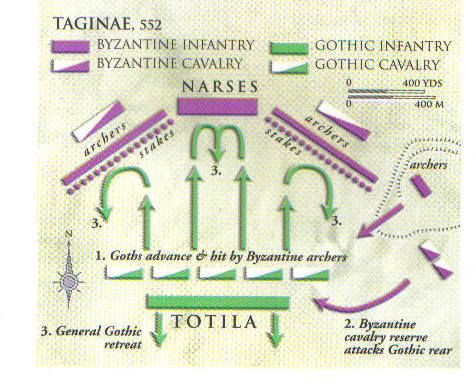 |
| Battle of Taginae - The battle to the death between the Ostrogothic Kingdom of Italy and the Eastern Roman Empire. |
General Narses vs. King Totila and the death of the Ostrogothic Kingdom
The Battle of Taginae brought an end to the long struggle between Byzantium and the Ostrogothic Kingdom in Italy.
During 550-51 Eastern Roman Emperor Justinian I started gathering a large expeditionary force totaling 20,000 or possibly 25,000 men. The Byzantine army was mostly cavalry, with some 8000 Byzantine foot archers. It was assembled at Salona on the Adriatic, comprising regular Byzantine units and a large contingent of foreign allies, notably Lombards, Heruls and Bulgars.
The imperial chamberlain (cubicularius) Narses was appointed to command in mid 551.
Narses moved down the Via Flaminia, heading for Rome. The Ostrogothic king, Totila, advanced with a smaller force of perhaps 13,000 men to intercept him at Taginae (the modern Gualdo Tadino). He arrived in time to force Narses to fight, or else make a perilous retreat back over the Apennines.
 |
| Roman Emperor Justinian I |
Totila, aware that he was outnumbered, and awaiting reinforcement of 2,000 addition troops on the way. At first the king negotiated with Narses, then advanced on the Byzantines, hoping to take them by surprise.
Narses enjoyed superiority in numbers, but deployed his army in a strong defensive position.
Narses ordered his 10,000 barbarian foederati to dismount, and form a deep phalanx in the center. The archers were divided into two sections, which were placed on either wing of the infantry. Then, the Byzantine cavalry was divided into two main wings, placed to the rear of the archers. Finally, a further 1500 horsemen were placed at the far left wing of the army; these men would be used to outflank the Gothic army, if the opportunity presented itself.
The Ostrogothic cavalry was drawn up into a long line, which probably accounted for over half of the entire army. Totila probably thought he could break the Byzantine center with a single cavalry charge. The Gothic foot soldiers, originally archers, were positioned in a single block behind the cavalry. The historian Procopius noted that Totila gave the unusual order that he entire army could only fight with their spears. Why he gave this command is one of history's mysteries.
Video of the Battle of Taginae
The Battle
On one flank was a small hill that offered the prospect of turning the Byzantine left, but Narses got to it first, occupying it with just fifty men, who held a defile there. Totila sent cavalry against them but the Byzantine infantry succeeded in holding off multiple attacks by Ostrogothic cavalry.
Again, King Totila played for time. There was even an individual challenge between warriors from both side out in no man's land between the armies.
Finally Totila's reinforcements arrives. Now Totila had his troops break for lunch.
 |
| Byzantine Infantry |
Narses fearing a trick permitted his troops to refresh themselves without leaving their positions. Totila, apparently hoping to take his enemy by surprise, launched a sudden large-scale mounted assault upon the Byzantine center. Ancient and modern authors have accused him of folly, but Totila probably sought to close with the enemy as fast as possible in order to avoid the effects of the formidable Byzantine archery.
Narses was prepared for such a move, however, and ordered the archers massed on his flanks to incline their front towards the center so that his battle-line became crescent-shaped. Caught in the enfilading fire from both sides, the Ostrogothic cavalry sustained high casualties and their attack faltered.
The Goths who reached the infantry block were repelled with heavy losses. Totila sent wave after wave of troops that became so disorganized by the raining arrow storm, by the time they met the dismounted infantrymen they were completely broken. This folly continued through the afternoon.
The Gothic infantry never even engaged in actual combat as they hesitated to advance far enough to actually become effective. They were kept in the rear of the advance, fearing that Narses' horsemen would outflank them.
The Byzantine center began to push Totila's cavalry backwards onto their own line of infantry, At that critical moment, sometime in the early evening, Narses charged with his own cavalry – nearly all of them Byzantine heavy cavalry – that had been held in reserve. The retreat quickly turned into a rout, as the Gothic cavalry in their haste ran right over their own infantry, who joined them in the withdrawal.
The only casualty figures given for this battle were by Procopius, who said that 6,000 Ostrogothic cavalry were slain in the battle. The majority of the Byzantine casualties were sustained by their foederati, who bore the brunt of the initial fighting.
King Totila was either killed on the battlefield or killed shortly afterward after fleeing with several followers.
6th Century Eastern Roman Cavalry
 |
| The Roman Empire at the end of the Gothic Wars. |
 |
| Gothic warriors that could have faced Narses in Italy. |







